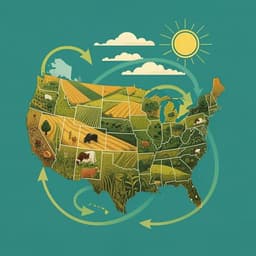
Food Science and Technology
Latitudinal gradient in dairy production with the introduction of farming in Atlantic Europe
M. Cubas, A. Lucquin, et al.
This fascinating study by Miriam Cubas and colleagues explores the culinary habits of early farming communities along the European Atlantic seaboard, uncovering an intriguing absence of aquatic foods and a notable rise in dairy consumption as communities migrated northward. Learn how this research sheds light on our understanding of food adaptation and lactase persistence evolution!
~3 min • Beginner • English
Introduction
The paper addresses how early Neolithic agro-pastoral economies developed along the Atlantic seaboard of Europe and to what extent regional environmental and cultural contexts shaped subsistence practices. Prior models often contrasted demic diffusion and acculturation, but recent genetic evidence supports a Near Eastern origin for Europe's earliest farmers while offering limited resolution on socio-economic change. The study seeks to clarify: (1) whether aquatic resources continued to be processed with the advent of farming in coastal Atlantic regions; and (2) how the balance between meat and milk production varied geographically during the earliest phases of the Neolithic (ca. 5500–3500 cal BC). The work is significant for understanding regional adaptations during the spread of farming and their potential evolutionary implications (e.g., selection for adult lactase persistence). To this end, the authors employ organic residue and isotopic analyses of pottery to reconstruct vessel use and infer animal management strategies across a broad latitudinal transect.
Literature Review
Previous organic residue studies have revealed that dairying was present from the earliest Neolithic in Southern, Central, and Northern Europe, challenging the view that milk use emerged late. However, the scale of dairying relative to meat production has remained unclear, and regional variability is increasingly apparent. Along Atlantic Europe, most residue work has focused on Britain and Ireland, despite dense Late Mesolithic occupations in Brittany, Denmark, Cantabrian Spain, and Portuguese estuaries that heavily exploited marine resources. Stable isotope studies of human remains from Early Neolithic coastal contexts often suggest limited marine protein consumption, though sample scarcity and method resolution prevent ruling out aquatic foods entirely. Archaeological evidence indicates diverse interactions between Mesolithic foragers and incoming farmers, from co-existence and technological exchange to apparent avoidance, with aDNA pointing to limited admixture. Faunal assemblages suggest a northward increase in cattle relative to ovicaprines, implying potential economic differences, but the extent and intensity of early dairying along the Atlantic margin were previously unknown.
Methodology
Study design and sampling: 246 Early Neolithic pottery sherds from 24 sites spanning central-southern Portugal, northern Spain, Atlantic France (Brittany and Normandy), and the Western Baltic were selected to represent initial Neolithic phases (ca. 5500–3500 cal BC; Western Baltic ca. 3950–3300 cal BC). Selection targeted morphological/decorative variability and spatial distribution within sites. New data were combined with previously published datasets from 39 sites in Britain, Ireland, and the Western Baltic to yield 647 potsherds for comparative analysis.
Lipid extraction and quantification: Lipids were extracted by direct acidified methanol trans-esterification from 246 sherds (methanol + H2SO4, heated 70 °C, 4 h; hexane extraction). An internal standard (C36 n-alkane) was used for quantification. Most Iberian and French samples (185/224) also underwent DCM:MeOH solvent extraction, with derivatization by BSTFA. GC-FID quantified lipids; GC-MS characterized molecular profiles (DB-5MS; SIM and scan modes), including targeted detection of aquatic biomarkers (ω-(ω-alkylphenyl) alkanoic acids, isoprenoid fatty acids) using a DB-23 column and phytanic acid diastereomer ratios. High-temperature GC-MS was used for triacylglycerols.
Compound-specific isotope analysis: GC-C-IRMS measured δ13C of methyl palmitate (C16:0) and methyl stearate (C18:0) from 225 new samples. Instrument accuracy (<0.3‰) and precision (<0.5‰) were verified with standards; samples run in duplicate (mean SD 0.1‰ for both fatty acids). Data were corrected for methylation and the Suess effect. Archaeological δ13C values were compared with modern authentic reference fats/oils (ruminant adipose, ruminant dairy, non-ruminant/porcine, marine oils). Source identification used absolute ranges and Δ13C (δ13C18:0 − δ13C16:0) thresholds established in prior work.
Statistical and modeling approaches: A Bayesian mixing model (FRUITS v3.0 Beta) estimated proportional contributions of four fat sources (marine, ruminant adipose, ruminant dairy, non-ruminant) using median regional δ13C16:0 and δ13C18:0 values (excluding bimodal Western Baltic). Concentration data for fatty acids were drawn from USDA databases; uncertainties incorporated via covariance and SEM. MCMC runs employed burn-in and convergence diagnostics.
Spatial modeling: AverageR (generalized additive mixed model with thin plate regression spline and site random intercept) generated spatial estimates of Δ13C across Atlantic Europe. SpreadR (Bayesian extreme quantile regression with spline) estimated earliest Neolithic arrival dates (0.5% quantile). Uncertainty reported as SEM, acknowledging potential underestimation for SpreadR.
Chronological context and controls: AMS 14C dates place all sampled contexts in Early Neolithic horizons contemporaneous with initial domesticated plants/animals. The study explicitly tracks latitudinal patterns while recognizing temporal offsets in regional Neolithization.
Key Findings
- Analytical yield: Of 246 newly analyzed sherds, 234 (95%) contained interpretable lipid quantities (>5 μg g−1). Combined with published datasets, 647 sherds were available for isotopic comparison.
- Absence of marine processing on Atlantic seaboard: No aquatic biomarkers were detected in Early Neolithic pottery from Atlantic Iberia, France, Britain, or Ireland despite sensitive detection protocols and the coastal contexts of many sites. In contrast, Western Baltic Early Neolithic (TRB) pottery yielded stable carbon isotope values and biomarkers indicative of marine oils, evidencing continuity from Late Mesolithic Ertebølle culinary practices.
- Latitudinal gradient in dairying: There is a significant negative correlation between latitude and Δ13C (more negative indicates more dairy) along the Atlantic transect from Portugal to Scotland (Spearman ρ = −0.67; p = 7.83×10−75). Higher latitudes show a greater proportion of dairy-derived lipids in pottery.
- Regional proportions: Over 80% of Early Neolithic pottery from Britain and Ireland contained dairy fats—approximately twice the frequency observed in northwestern France. Median Δ13C regional summaries (Fig. 1c) indicate increasingly negative Δ13C from south (central-southern Portugal mean ≈ −1.10‰) to north (North England/Scotland/Ireland mean ≈ −4.58‰), consistent with a dairying increase.
- Bayesian mixing model: FRUITS outputs corroborate the northward increase in dairy lipid contributions relative to carcass fats, despite equifinality in individual-source discrimination, reinforcing the Δ13C-based interpretation.
- Subsistence and animal management: Patterns suggest cattle-centered economies with intensive dairying at higher latitudes; in southern regions (Iberia), economies more oriented toward meat or mixed meat/milk use, aligning with ovicaprine-dominant faunas. In Atlantic France, pottery evidences mixed meat/milk use consistent with cattle husbandry profiles indicative of dual exploitation.
- Temporal correlation: Because the latitudinal transect also follows a temporal gradient of Neolithic arrival (ca. 5400/5300 cal BC south to ca. 3500 cal BC north), the frequency of dairy residues co-varies with both latitude and date of domesticate introduction.
Discussion
The findings demonstrate distinct regional trajectories in early Neolithic culinary practices along Atlantic Europe. The near-total absence of aquatic processing in pottery outside the Western Baltic indicates a marked economic shift with farming, even in coastal settings formerly dominated by fishing and shellfish gathering, or alternatively suggests that aquatic resources were processed via other means. The Western Baltic stands out as a case of cultural continuity where Ertebølle culinary traditions persisted into the TRB despite the adoption of farming.
The strong latitudinal gradient in dairy residues implies that early farmers increasingly relied on dairying as they expanded northwards. This likely reflects a combination of environmental constraints, resource availability (pasture, water, forage), and the need for specialized herd management (e.g., extended birthing seasons, early weaning) to sustain milk production under higher-latitude conditions. Archaeozoological data align with this pattern: ovicaprine-dominant assemblages in Iberia correspond to lower dairy frequencies, while cattle-focused economies in northern France and the British Isles show more intensive dairying.
These results address the initial questions by showing (1) limited continuity of aquatic processing in pottery with the onset of farming except in the Western Baltic, and (2) clear geographic variability in early animal exploitation, with dairying intensifying towards higher latitudes and later Neolithization fronts. Dairying’s nutritional benefits (notably vitamin D and fats) may have been particularly advantageous in higher latitudes and where arable farming was variable or constrained, offering a buffer during pioneer farming expansions. The observed gradient could have contributed to spatially variable selection pressures for adult lactase persistence, potentially underpinning higher modern LP frequencies in northwestern Europe, while acknowledging later demographic events (e.g., Bronze Age migrations) that also affected LP distributions.
Conclusion
This study provides a supra-regional reconstruction of Early Neolithic pottery use across the Atlantic seaboard, revealing: (i) an absence of aquatic processing in pottery outside the Western Baltic; and (ii) a pronounced latitudinal increase in dairy product processing, supported by isotopic signatures and Bayesian mixing models. The results suggest that early farmers adapted their economies, increasingly emphasizing dairying as they moved into higher-latitude environments and as Neolithization progressed northwards. These subsistence strategies likely intersected with cattle-focused husbandry and may have influenced evolutionary trajectories for lactase persistence in Europe.
Future research should integrate higher-resolution genomic data to clarify farmer–forager interactions in coastal zones, expand residue studies to underrepresented Atlantic regions and site types, and couple lipid residue data with detailed zooarchaeological and archaeobotanical records to refine models of early agro-pastoral adaptation and seasonal herd management.
Limitations
- Method equifinality: The Bayesian mixing model highlights high equifinality; isotopic signatures alone may not definitively exclude certain sources for individual vessels.
- Detection bias for aquatic resources: Absence of aquatic biomarkers in Atlantic pottery does not preclude aquatic consumption; resources might have been processed in non-ceramic contexts or in vessels not sampled.
- Temporal confounding: The latitudinal transect also reflects staggered Neolithic arrival dates (~1500-year span), so dairy frequency co-varies with both latitude and chronology.
- Sample and context constraints: Early Neolithic coastal human remains are scarce in Iberia and France; faunal remains are often poorly preserved in acidic soils, limiting direct comparisons. Pottery assemblages can be small/fragmentary, and only earliest phases were sampled.
- Spatial model uncertainty: SpreadR’s uncertainty (SEM) is a low estimate and may understate true uncertainty in arrival-time reconstructions.
Related Publications
Explore these studies to deepen your understanding of the subject.







